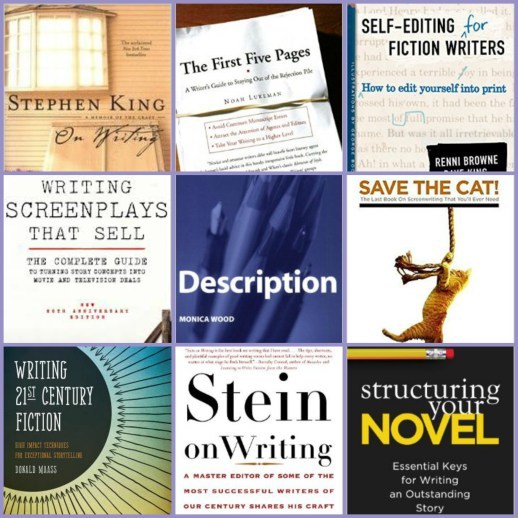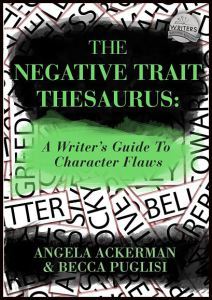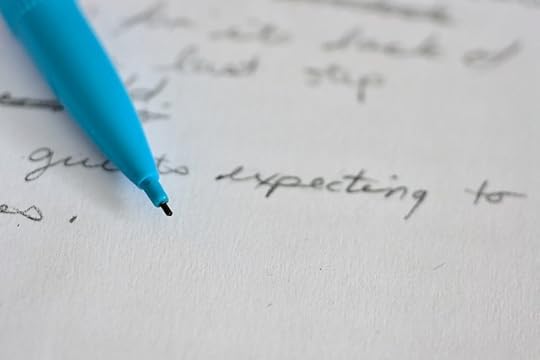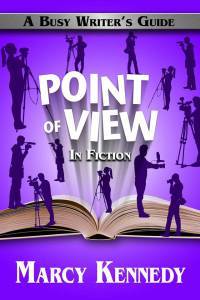Angela Ackerman's Blog: Writers Helping Writers, page 140
December 8, 2015
Win, Win, Win! Stuff Your Stocking With Writerly Goodies
Becca and I love the holiday season–everything is colorful and cheery, the house is filled with cinnamon and ginger as we flex up our baking muscles, and we get to take time to tell you just what you mean to us. Seriously, you guys are the very best readers out there! We are so lucky to have you in our world.
Another terrific thing about this season is that we can celebrate the things we love, and around here, that’s all things writerly. This year with the launch of One Stop For Writers, our mantra is “Elevate your Storytelling.” So Becca, Lee & I sat down and listed out the top three books we feel have elevated our own craft beyond measure.
Why? So we can give them away to you!
Of course, this exercise caused some issues. Choosing ONLY 3 books? So hard! Plus, several of our “top 3” book choices were the same. And I don’t want to point fingers, but certain individuals *coughBeccacoughLeecough* STOLE some of my choices.
But no worries, there are so many amazing books out there that have helped us become stronger writers that we were able to sort it out.
With that, I bring you the 9 Wonders of the Writing Reference World:
 1. On Writing 2. First Five Pages 3. Self-Editing For Fiction Writers 4. Writing Screenplays That Sell 5. Description 6. Save the Cat 7. 21st Century Fiction 8. Stein on Writing 9. Structuring Your Novel
1. On Writing 2. First Five Pages 3. Self-Editing For Fiction Writers 4. Writing Screenplays That Sell 5. Description 6. Save the Cat 7. 21st Century Fiction 8. Stein on Writing 9. Structuring Your NovelWant to elevate your storytelling and win a kindle copy of one of these “best of the best” craft books? Of course you do!
To Enter:

Grow your craft with One Stop’s powerful library. Certificates never expire.
1) Post in the comment section with your TOP 4 book choices. (This will be by random draw, and first come first serve.)
2) Tell us what book has elevated your storytelling. We would love to hear what has given your writing a boost!
3) Pay-it-forward by naming a writer friend (first name is fine if you prefer) who has helped you. If you win, we will send them a 1 month Gift Certificate for One Stop For Writers for their own stocking.
Must be 18, no purchase necessary, open to all unless prohibited by law. For the full legal rules and disclaimers, go here.
As always, social sharing is appreciated, but never a condition of our giveaways. Winners will be drawn and announced on Saturday, December 12th!
The post Win, Win, Win! Stuff Your Stocking With Writerly Goodies appeared first on WRITERS HELPING WRITERS™.
December 5, 2015
Emotional Wounds Thesaurus Entry: Failing To Do the Right Thing
When you’re writing a character, it’s important to know why she is the way she is. Knowing her backstory is important to achieving this end, and one of the most impactful pieces of a character’s backstory is her emotional wound. This negative experience from the past is so intense that a character will go to great lengths to avoid experiencing that kind of pain and negative emotion again. As a result, certain behaviors, beliefs, and character traits will emerge.
Characters, like real people, are unique, and will respond to wounding events differently. The vast array of possible emotional wounds combined with each character’s personality gives you many options in terms of how your character will turn out. With the right amount of exploration, you should be able to come up with a character whose past appropriately affects her present, resulting in a realistic character that will ring true with readers. Understanding what wounds a protagonist bears will also help you plot out her arc, creating a compelling journey of change that will satisfy readers.
NOTE: We realize that sometimes a wound we profile may have personal meaning, stirring up the past for some of our readers. It is not our intent to create emotional turmoil. Please know that we research each wounding topic carefully to treat it with the utmost respect.

Credit: Pixabay
Examples: It’s impossible to do the right thing all the time. Sometimes, the result of a character’s failing to do the right thing is small: momentary guilt, a temporary rift with a friend, etc. But sometimes the natural consequences of their failures can be monumental, resulting in permanent loss, shame, self-doubt, and self-loathing. These events can be wounding ones that can greatly impact our characters over time.
Not standing up for someone who is being bullied, belittled, or victimized
Looking the other way as a crime is committed
Not helping someone (a vagrant, a child, etc.) when help could have been given
Giving in to peer pressure
Letting someone drive who is impaired
Knowing that a relationship is falling apart but not taking steps to fix it
Making choices that cause others to stumble (abusing alcohol or prescription drugs and exposing one’s children or younger siblings to them)
Taking a bribe
Giving advice that benefits oneself rather than the hearer
Not blowing the whistle on an influential organization or person who is acting unethically
Confirming someone else’s lie
Not confronting a friend who is endangering him/herself (with an eating disorder, addictions, unsafe sexual practices, suicidal tendencies, etc.)
Acting selfishly and neglecting those in one’s charge
Telling a secret or private information that one promised to keep
Deliberately attempting to hide or twist the truth
Being suspicious of someone but not acting on one’s instincts
Exploiting someone who is vulnerable or in need of help
Giving in to destructive temptations (having an affair, indulging in addictions, being financially irresponsible, etc.)
Basic Needs Often Compromised By This Wound: love and belonging, esteem and recognition, self-actualization
False Beliefs That May Be Embraced As a Result of This Wound:
I’m a bad person.
I can’t trust my own instincts.
I can’t be relied upon to do what’s right.
I’m untrustworthy.
I’m too weak to stand up to others.
One person’s actions don’t matter, anyway.
It wasn’t my fault; bad things would have happened even if I had acted differently. (Denying one’s responsibility for what happened)
Positive Attributes That May Result: alert, cautious, discreet, honest, just, merciful, observant, protective
Negative Traits That May Result: addictive, apathetic, callous, controlling, cowardly, cruel, defensive, devious, evasive, gullible, hypocritical, ignorant, insecure, irresponsible, manipulative, morbid, needy, reckless, resentful, self-destructive, selfish, stubborn, subservient, temperamental, timid, uncooperative, unethical, weak-willed, withdrawn
Resulting Fears:
Fear of losing friends if one speaks against them
Fear of being responsible for someone being hurt again
Fear of being manipulated or easily led by others
Fear of making the wrong choice
Fear of putting one’s own desires above the needs of others
Possible Habits That May Emerge:
Always relying on others to make important decisions because one doesn’t trust one’s instincts
Refusing to see injustice anywhere out of a desire to avoid responsibility
Turning inward
Doubting oneself
Becoming more cautious; thinking decisions through more carefully in order to come to the right conclusions
Getting second opinions before taking action
Not sharing one’s opinions out of a fear they will be disagreed with
Becoming very black-and-white in one’s beliefs and decisions, making it very easy for one to know right from wrong
Loosening one’s opinions about right and wrong so they become less obvious, making it easier to make the decisions one wants without experiencing guilt
Being determined to not make the same mistake in the same area again (learning from one’s mistake)
Increased empathy for others
Becoming callous to the needs of others
TIP: If you need help understanding the impact of these factors, please read our introductory post on the Emotional Wound Thesaurus. For our current list of Emotional Wound Entries, go here.
For other Descriptive Thesaurus Collections, go here.
The post Emotional Wounds Thesaurus Entry: Failing To Do the Right Thing appeared first on WRITERS HELPING WRITERS™.
December 2, 2015
Writers Helping Writers Thanks YOU for Helping US Pay It Forward
Every December, this is my favorite post to write. I look forward to it all year long, and it is only because of you and your support of Becca and me that I am able to write it.
As many of you know, each year Writers Helping Writers makes a charitable donation to a specific organization. Because you guys are so lovely and buy our books for yourselves and as gifts for others, over the years, Becca and I have been able to give several thousand dollars to different charities. You have fought the war against poverty, helped victims escape the sex trade and so much more.
 Each January we pick a “charity of the year” to support. This year we chose Farm Sanctuary, an organization that rescues mistreated farm animals from abusive and hoarding situations, and seeks to educate developing countries regarding humane treatment. While Becca and I are not vegetarians, we still feel animals deserve to be treated as humanely as possible. And the reality is that our world is not always a kind one and some animals really need our help.
Each January we pick a “charity of the year” to support. This year we chose Farm Sanctuary, an organization that rescues mistreated farm animals from abusive and hoarding situations, and seeks to educate developing countries regarding humane treatment. While Becca and I are not vegetarians, we still feel animals deserve to be treated as humanely as possible. And the reality is that our world is not always a kind one and some animals really need our help.
However, as we prepare our donation to Farm Sanctuary, we can’t ignore the very raw and painful situation occurring right now on the world stage. I’m talking about Syria, and the horror that is occurring that is causing so many to flee their homes, facing untold peril to do so. As we sit safe in our homes in North America, it seems wrong to not do something when we can.
So, Becca and I are bringing on board a second charity this year.
After watching this video of an 18 month old child being saved by Turkish fisherman, we knew we wanted to support an organization that rescues those in peril.
 So, we’ve chosen MOAS (Migrant Offshore Aid Station) which sends out patrol boats to help refugees lost at sea. This is one of the lesser-known yet vitally important charities working to help Syrians.
So, we’ve chosen MOAS (Migrant Offshore Aid Station) which sends out patrol boats to help refugees lost at sea. This is one of the lesser-known yet vitally important charities working to help Syrians.
As always, deepest and most heartfelt thanks for all your support. When you buy our books, you not only allow Becca and I to do what we love, you also are paying-it-forward and helping others in many different ways.
Both charities will receive a $500 donation on behalf of Writers Helping Writers™. Look for our post in January when we choose our next charity-of-the-year!
The post Writers Helping Writers Thanks YOU for Helping US Pay It Forward appeared first on WRITERS HELPING WRITERS™.
December 1, 2015
Critiques 4 U
Courtesy: Pixabay
Happy December, everyone! November is such a crazy month for me, and this one was no different: my son’s 6th birthday (and party), my father-in-law’s birthday, Thanksgiving celebrations both at home and at school, decorating the house for Christmas. So many happy and exciting things, but I always breathe a sign of relief when November winds down and I can relax for a bit. And then December starts…
So before things get crazy again, I’m giving myself an early Christmas present and firing up our monthly critique contest. If you’re working on a first page and would like some objective feedback, please leave a comment that includes:
1) your email address. Some of you have expressed concern about making your email address public; if you’re sure that the email address associated with your WordPress account is correct, you don’t have to include it here. But if you do win and I’m unable to contact you through that email address, I’ll have to choose an alternate winner.
2) your story’s genre (no erotica, please)
ONLY ENTRIES THAT FOLLOW THESE INSTRUCTIONS WILL BE CONSIDERED
Three commenters’ names will be randomly drawn and posted tomorrow. If you win, you can email me your first page and I’ll offer my feedback. Best of luck!
The post Critiques 4 U appeared first on WRITERS HELPING WRITERS™.
November 29, 2015
Emotional Wound Entry: Having to Kill Another Person To Survive
When you’re writing a character, it’s important to know why she is the way she is. Knowing her backstory is important to achieving this end, and one of the most impactful pieces of a character’s backstory is her emotional wound. This negative experience from the past is so intense that a character will go to great lengths to avoid experiencing that kind of pain and negative emotion again. As a result, certain behaviors, beliefs, and character traits will emerge.
 Characters, like real people, are unique, and will respond to wounding events differently. The vast array of possible emotional wounds combined with each character’s personality gives you many options in terms of how your character will turn out. With the right amount of exploration, you should be able to come up with a character whose past appropriately affects her present, resulting in a realistic character that will ring true with readers. Understanding what wounds a protagonist bears will also help you plot out her arc, creating a compelling journey of change that will satisfy readers.
Characters, like real people, are unique, and will respond to wounding events differently. The vast array of possible emotional wounds combined with each character’s personality gives you many options in terms of how your character will turn out. With the right amount of exploration, you should be able to come up with a character whose past appropriately affects her present, resulting in a realistic character that will ring true with readers. Understanding what wounds a protagonist bears will also help you plot out her arc, creating a compelling journey of change that will satisfy readers.
NOTE: We realize that sometimes a wound we profile may have personal meaning, stirring up the past for some of our readers. It is not our intent to create emotional turmoil. Please know that we research each wounding topic carefully to treat it with the utmost respect.
Examples:
a forced initiation into a gang or military group
a parent protecting their child or themselves from a stranger
a parent protecting their child or themselves from a violent spouse
a child protecting a loved one
killing to escape confinement or torture
having to kill in battle (soldier) or as part of one’s job (a bank guard or police officer, etc.)
being forced to kill another as part of a sadistic game or situation
performing a mercy killing to end another’s extreme suffering
killing to protect those in one’s care
killing to protect one’s vital resources in dire circumstances
killing to obtain vital resources (food, water, weapons) for one’s family
Basic Needs Often Compromised By This Wound: safety and security, esteem and recognition, love and belonging
False Beliefs That May Be Embraced As a Result of This Wound:
I am a violent/dangerous person/a monster
The world is an evil place
I did the unthinkable and so am capable of anything
I will suffer damnation for what I’ve done
No one will ever trust me again
People look at me differently now
People are afraid to be around me or get close
People expect that I will just snap and commit violence
It doesn’t matter what I do, people will only see me as a killer
I can never balance the scales after taking a life, never make up for what I did
Positive Attributes That May Result: alert, appreciative, cautious, courageous, decisive, diplomatic, disciplined, independent, introverted, private, proactive, resourceful, protective, socially aware
Negative Traits That May Result: addictive, antisocial, controlling, cynical, defensive, humorless, impatient, inflexible, irrational, materialistic, needy, paranoid, pessimistic, prejudiced, suspicious, timid, vindictive, violent, withdrawn
Resulting Fears:
Note: fears will be circumstance-specific, but below are some possible suggestions
fear of strangers
fear of loud noises
fear of being confined
fear of poverty (if a factor)
fear of weapons
fear of the dark
fear of a specific people group associated with the event
Possible Habits That May Emerge:
having to know where one’s loved ones are at all times
increased security protocol for one’s home and family
difficulty building trust and friendships
avoiding sharing personal information
having a secret store for cash, weapons or other resources (whichever factors into the original situation)
avoiding answering the door when alone or if it is a stranger
not leaving one’s home, avoiding going places alone
assessing risks before making a decision, a lack of spontaneity
investigating people in one’s family life to determine if they pose a threat
taking care with one’s resources, avoiding wastefulness and debt that could narrow one’s options
thinking about the worst case scenario
difficulty relaxing or enjoying the little things
noticing dangers and threats constantly
TIP: If you need help understanding the impact of these factors, please read our introductory post on the Emotional Wound Thesaurus. For our current list of Emotional Wound Entries, go here.
For other Descriptive Thesaurus Collections, go here.
Image: Satlitov @ pixabay
The post Emotional Wound Entry: Having to Kill Another Person To Survive appeared first on WRITERS HELPING WRITERS™.
November 26, 2015
Avoid Black Friday Mayhem & Create Happy Writers
 Well, the terrifying shopping season is upon us. I find people either embrace Black Friday with incredible enthusiasm, or they want to get as far from it as they can. I am not a big shopper on my best day, so you can probably guess I’ll be hanging out at home, and any shopping I do will be from my keyboard.
Well, the terrifying shopping season is upon us. I find people either embrace Black Friday with incredible enthusiasm, or they want to get as far from it as they can. I am not a big shopper on my best day, so you can probably guess I’ll be hanging out at home, and any shopping I do will be from my keyboard.
If you’re like me, then I have some good news for you: maybe we can knock a few people off your Christmas list if they happen to be the writerly sort!
 First of all, I have created a Pinterest Board FULL of gifts for writers. Oh, the cool things I have found. (I hope Santa is listening!)
First of all, I have created a Pinterest Board FULL of gifts for writers. Oh, the cool things I have found. (I hope Santa is listening!)
Second, Becca and I have put together a page full of the top writing books that have helped our careers immensely. These are our personal recommendations, and we hope you enjoy them as much as we do.
Or, if you want a few more ideas for a specific area of craft, then check Amazon’s Best Sellers & Most Wished For lists.
 Finally, if you have been thinking about taking One Stop For Writers for a spin or know someone else who wants to, we now have Gift Certificates available, so if you like, swing by and check it out. They never expire.
Finally, if you have been thinking about taking One Stop For Writers for a spin or know someone else who wants to, we now have Gift Certificates available, so if you like, swing by and check it out. They never expire.
Speaking of One Stop, a newsletter just went out that details our planned upgrades. If you’re interested, you can read it here.
So, what are your BLACK FRIDAY plans…fight the crowds, shop at home, or get some writing done? Let me know in the comments!
Image 1: HerbiFot @ Pixabay
The post Avoid Black Friday Mayhem & Create Happy Writers appeared first on WRITERS HELPING WRITERS™.
November 25, 2015
The Subtle Knife: Writing Characters Readers Trust But Shouldn’t
I don’t know about you, but I love reading books where the author encourages me to draw conclusions that are wrong. Case in point–untrustworthy characters who I trust anyway. Like all writers, I am ultra aware of character cues and actions as I read, so when I’m led astray and find out someone I believed to be good really isn’t, I want to cheer and tell the author, “Well done!”
Tricking readers in this manner is difficult.
 In real life, all of us are body language experts. At least 93% of communication is nonverbal, meaning we are very adept at ‘reading’ other people by their mannerisms, gestures, habits and voice changes. In books, this skill allows us to pick up on nonverbal cues which communicate a character’s emotions. Plus, if we are in the dishonest character’s POV, we also have access to their thoughts and internal visceral sensations (heartbeat changes, adrenaline shifts and other uncontrollable fight-or-flight responses). All of this means that tricking the reader can be very tough.
In real life, all of us are body language experts. At least 93% of communication is nonverbal, meaning we are very adept at ‘reading’ other people by their mannerisms, gestures, habits and voice changes. In books, this skill allows us to pick up on nonverbal cues which communicate a character’s emotions. Plus, if we are in the dishonest character’s POV, we also have access to their thoughts and internal visceral sensations (heartbeat changes, adrenaline shifts and other uncontrollable fight-or-flight responses). All of this means that tricking the reader can be very tough.
There are several ways to make the reader believe one thing while another thing is true.
One technique is the red herring. This is where a writer nudges a reader in one direction hard enough that their brain picks up on ‘planted’ clues meant to mislead them. So for example, let’s say I had a character who was a pastor and youth councilor for his church and he spent his weekends working with homeless teens, trying to get them back into group homes. The reader will begin to get a certain image in their mind.
If I then further describe him as slightly bald with a bad taste in fashion (imagine the kind of guy that wears those awful patterned sweater vests) but who has a smile for everyone he meets, it’s a good bet that I’ve disarmed the reader. They’ve written this character off as a nice, honest guy. Even though his life is all about the church, no way could he be the one stealing cash from the collection box, or the man having affairs with depressed women parishioners, or playing Dr. Death by administering heroin to street teens, right?
Another technique is pairing. Similar to a red herring, pairing is when we do two things at once to mask important clues. If, as an author, I show my friendly pastor leaving an alleyway at night and then have a car crash happen right in front of him, which event will the reader focus on? And if later, the police find another overdosed teen nearby as they interview the pastor about the accident, commending him from pulling a woman from the wreckage before the car could explode…would the reader put two and two together? If I did my job right, then no.
 A third technique is to disguise aspects of his “untrustworthy nature” using a Character Flaw. After all, no one is perfect. Readers expect characters to have flaws to make them realistic. If our nice pastor (am I going to go to Hell for making my serial killer a pastor?) is characterized as absent-minded with a habit of forgetting names, misplacing his keys, or starting service late and flustered because of a mishap, later when the police ask him when he last saw dead teen X and he can’t quite remember, readers aren’t alarmed. After all, that’s just part of who the character is, right?
A third technique is to disguise aspects of his “untrustworthy nature” using a Character Flaw. After all, no one is perfect. Readers expect characters to have flaws to make them realistic. If our nice pastor (am I going to go to Hell for making my serial killer a pastor?) is characterized as absent-minded with a habit of forgetting names, misplacing his keys, or starting service late and flustered because of a mishap, later when the police ask him when he last saw dead teen X and he can’t quite remember, readers aren’t alarmed. After all, that’s just part of who the character is, right?
When your goal is to trick your readers, SET UP is vital.
If the clues are not there all along, people will feel ripped off when you rip the curtain aside. Make sure to provide enough details that they are satisfied you pulled one over them fair and square!
What techniques do you use to show a character is untrustworthy? Any tips on balancing your clue-sprinkling so that the reader doesn’t pick up on your deceit before you’re ready for them to? Let me know in the comments!
Image: lllblackhartlll @ Pixabay
The post The Subtle Knife: Writing Characters Readers Trust But Shouldn’t appeared first on WRITERS HELPING WRITERS™.
November 23, 2015
Resources for Television Writers
At Writers Helping Writers, we want to support everyone. Screenwriters, novelists, picture book authors, ghostwriters, journalists, magazine writers—we love you all and want to see you succeed! So while we tend to focus on novel writing, we like to also publish posts that deal with specific genres and formats. For this reason, we’re excited to host Lesley Vos, who’s here to share some information about writing for TV—a topic Angela and I have no experience with and so haven’t discussed much.
Now, before you change the channel because you “don’t write for TV,” keep in mind that we can learn a lot from writers of other genres. Stephen King has a lot of wisdom to offer for everyone, not just those in the horror business. Save The Cat! The Last Book on Screenwriting You’ll Ever Need was a game-changer for me, bringing the complex nature of story structure down to a manageable level. And I don’t write screenplays. So keep an open mind and read on to see what nuggets you might glean.
was a game-changer for me, bringing the complex nature of story structure down to a manageable level. And I don’t write screenplays. So keep an open mind and read on to see what nuggets you might glean.

Courtesy: Bruce Guenter @ Creative Commons
“If you read a lot of books, you’re considered well read. But if you watch a lot of TV, you’re not considered well viewed.”– Lily Tomlin
Do you write for TV? Or do you dream of becoming a TV writer whose scripts will garner many fans and followers?
If so, you’ll need some help to learn the art of screenwriting and improve your general skills. Small tips, writing rules, online references and resources for TV writers – they all can come in handy if you want to be a real master of your trade.
Things to remember when you write for TV
When a person decides to join a team of professional TV writers, he often doesn’t know what’s involved. Television writing has its specifications; some of them are the same as for other genres, and some are different. You have to be familiar with the specifics of writing for TV if you’re going to succeed in this business. A few general things to keep in mind:
Be literate.
Know how to tell stories.
Understand the four-act structure.
Know what a script is and how to write one.
Be able to capture the style of the TV shows you want to write for.
Know how to structure scenes and acts.
Be able to capture the voice of each character.
Clare Dowling, a writer behind twelve seasons of Fair City, has posted this very good article on tips for TV writers.
Online resources to bookmark for TV writers
Helping Writers Become Authors – A website by K.M. Weiland where she shares insights into writing powerful scenes, structuring your stories, creating awesome characters, and much more. Useful content for every TV writer to have.
Genre Hacks – A website by Sean Hood where he shares his filmmaking experience and posts interviews and discussions on writing TV scenes and using various related technologies. He is a professional screenwriter with a lot of practical knowledge that can benefit TV writers.
Save the Cat – A website by Blake Snyder, a screenwriter and producer. Here you’ll find workshops, seminars, script coverage from screenwriting experts, books on screenwriting, useful resources to develop screenwriting skills, and much more.
Final Draft — A website where one can check all the news and events of the screenwriting world, read articles and interviews on writing for TV, and watch tutorial videos. The CEO of Final Draft is Marc Madnick, a professional screenwriter who has been working in this field since 1986.
Film Script Writing – A website containing real scripts (Alien, Raiders of the Lost Ark, When Harry Met Sally, etc.) that are available to the public. Reading these familiar and successful examples can help writers learn the nuances and details of scriptwriting in their own genres and find out if their scripts are structured the right way.
John August’s Blog – A website where the experienced screenwriter shares his knowledge and reveals the secrets behind television writing. Many interesting stories, interviews, tips, and tricks for writing TV scripts can be found here. You are welcome to contact John and ask him questions, too.
Movie Bytes – A website with information on screenwriting contests and markets. You are welcome to take part, to share your experiences, to learn from experts, to read the latest news from the world of TV writing, and more.
Syd Field – This resource provides workshops and online courses for those interested in learning the skill of screenwriting. It includes useful tools for writers, articles and interviews, Field’s books on screenplays – all of this information is a must-see for those who want to write for TV.
Script Shadow – This website reviews the latest scripts in Hollywood and lets you take part in different contests for screenwriters. Movie reviews, advice on writing, articles to learn something new on writing for TV – they all can be found here. Plus, you can send them your own script for a review.
Bonus: Useful software for TV writers to bookmark
Looking for something more practical to help with writing your TV scripts? These tools might be useful:
Fountain – A tool that allows you to write in plain texts and export scripts to HTML, PDF, or Final Draft. This is a markup syntax for writing, editing, and sharing your screenplays.
Scrivener – A tool for generating content and composing and structuring long documents. Scrivener gives you control over formatting and is focused on helping you complete your first draft.
Celtx – A tool that lets you create scripts, schedules, cast&crew reports, and other writings needed for production.
In closing, don’t be afraid of screenwriting. Learn its genres to improve your skills and write desirable scripts for TV. Read books on screenwriting, ask experts, follow their blogs, take part in contests, and you just might end up becoming a TV guru on someone’s list of screenwriting resources down the road.
About the author: Lesley Vos is a writer. She is honored to contribute her writings to many websites, sharing her experience and helping others improve their writing skills. You are welcome to check Lesley’s profile here or contact her on G+ .
The post Resources for Television Writers appeared first on WRITERS HELPING WRITERS™.
November 21, 2015
Emotional Wounds Thesaurus: Getting Lost in a Natural Environment
When you’re writing a character, it’s important to know why she is the way she is. Knowing her backstory is important to achieving this end, and one of the most impactful pieces of a character’s backstory is her emotional wound. This negative experience from the past is so intense that a character will go to great lengths to avoid experiencing that kind of pain and negative emotion again. As a result, certain behaviors, beliefs, and character traits will emerge.
Characters, like real people, are unique, and will respond to wounding events differently. The vast array of possible emotional wounds combined with each character’s personality gives you many options in terms of how your character will turn out. With the right amount of exploration, you should be able to come up with a character whose past appropriately affects her present, resulting in a realistic character that will ring true with readers. Understanding what wounds a protagonist bears will also help you plot out her arc, creating a compelling journey of change that will satisfy readers.
NOTE: We realize that sometimes a wound we profile may have personal meaning, stirring up the past for some of our readers. It is not our intent to create emotional turmoil. Please know that we research each wounding topic carefully to treat it with the utmost respect.

Credit: Richard Leeming @ Creative Commons
Examples: Becoming lost for an extended period of time…
in the woods
in the mountains
in the desert
while hiking or camping
Basic Needs Often Compromised By This Wound: physiological needs, safety and security
False Beliefs That May Be Embraced As a Result of This Wound:
I am incompetent.
I can’t trust my instincts.
I cannot save myself; I need others to rescue me.
I don’t need anyone else; I can take care of myself.
Being alone is bad.
I can never be truly safe.
Nothing I do matters because everything is determined by fate.
Positive Attributes That May Result: adaptable, alert, cautious, independent, observant, optimistic, patient, persistent, resourceful, sensible,
Negative Traits That May Result: controlling, defensive, humorless, insecure, irrational, lazy, martyr, morbid, needy, nervous, obsessive, paranoid, pessimistic, possessive, rebellious, reckless, resentful, self-destructive, self-indulgent, selfish, superstitious, temperamental, timid, uncommunicative, uncooperative, withdrawn, worrywart
Resulting Fears:
Fear of the landscape in which one was lost (forests, mountains, deserts, etc.)
Fear of wild animals
Fear of the dark
Fear of not having enough to eat
Fear of being alone
Fear of crowds
Fear of noisy places
Fear of venturing too far from home
Fear of new places
Fear of isolated places
Possible Habits That May Emerge:
Becoming homebound; rarely leaving one’s home
Avoiding places like the one where one was lost
Becoming obsessed with places like the one where one was lost
Hoarding food, blankets, or whatever else would have staved off suffering during one’s trial
Being thrifty with one’s resources
Appreciating small comforts
Withdrawing from others
Becoming dependent on others
Never going anywhere alone
Avoiding new places
Refusing to accept help from others
Relocating to a home where one feels secure, be that away from people or nearer to them
No longer adhering to social norms (ignoring personal space, undressing in public, not bathing, etc.)
TIP: If you need help understanding the impact of these factors, please read our introductory post on the Emotional Wound Thesaurus. For our current list of Emotional Wound Entries, go here.
For other Descriptive Thesaurus Collections, go here.
The post Emotional Wounds Thesaurus: Getting Lost in a Natural Environment appeared first on WRITERS HELPING WRITERS™.
November 18, 2015
How to Decide How Many POV Characters Our Book Needs
Becca and I see certain questions pop up in our email boxes over and over, and one that always comes up during NaNoWriMo season is the question of how many POVs a novel should have.
 Like so many questions, this isn’t a cut-and-dry answer; so much depends on the type of story being told, what the author needs to achieve through multiple POVs, and to a lesser degree, the experience of the writer themselves. So I’m happy author Marcy Kennedy is here with some excellent metrics to consider when planning a novel and choosing how many POV characters to include.
Like so many questions, this isn’t a cut-and-dry answer; so much depends on the type of story being told, what the author needs to achieve through multiple POVs, and to a lesser degree, the experience of the writer themselves. So I’m happy author Marcy Kennedy is here with some excellent metrics to consider when planning a novel and choosing how many POV characters to include.
 One of the most common challenges for us as writers is deciding how many point-of-view characters we should use, and yet a lot of the advice we hear can be too generic. Use the right number for your genre. Don’t use more than three.
One of the most common challenges for us as writers is deciding how many point-of-view characters we should use, and yet a lot of the advice we hear can be too generic. Use the right number for your genre. Don’t use more than three.
While those tips are good general advice, they’re often not specific enough to actually answer our question. Our story might seem to need more than the standard advice would recommend. Or there might not even be a “standard” for our genre. How do we decide how many point-of-view characters to include?
One technique we can use for figuring out what’s best for our individual story is to write down all the potential point-of-view characters we might want to use, and then ask ourselves the following questions.
Who is the protagonist?
Our protagonist is the person whose goal drives the story. Most of the time, we need our protagonist to also be a point-of-view character (and to receive the majority of our scenes). Identify them first, and then you don’t have to consider them in the rest of the questions.
Would it improve the story to include scenes from the antagonist’s viewpoint?
In some stories, we don’t want to delve into the mind of our antagonist, either because the antagonist is an especially twisted villain or because revealing the identity or plans of the antagonist would ruin the tension. In other stories, knowing the antagonist and his or her plans increases the tension as readers worry about whether our heroes will spot the trap in time.
What’s the scope of our story?
An epic fantasy spanning five planets where the fate of the galaxy is at stake might require more point-of-view characters than the coming-of-age story of a young woman in feudal Japan. Generally speaking, the smaller the scope, the fewer point-of-view characters we need. The larger the scope, the more we can reasonably use, but that doesn’t mean we must or should—which is where the other questions come in.
Does every potential point-of-view character influence the plot in a significant way?
This is a good question for checking that each potential point-of-view character is essential. If a character could be cut without having to change the plot in any significant way, or if another character could easily step in and take their place, they probably aren’t a good choice for a point-of-view character because they’re expendable.
Does including this point-of-view character’s perspective enhance the theme?
Theme is always a tricky area for writers. We don’t want readers to feel like we’re beating them over the head with our message. Theme should develop through our main character’s growth arc and the challenging decisions they face, but another way to enhance our theme is to have characters approach it from varying angles and to take different sides on the issue. Those other characters don’t necessarily need to be point-of-view characters, though. So what we want to look at is whether we need to be inside a character to truly understand their opinion and stance on the issue.
Say we’re writing a mystery and we have a detective and her partner. The detective is our protagonist. She’s the one driving our story. So do we also need scenes from the viewpoint of her partner? Maybe, maybe not.
If he’s only there to be her sounding board, then we probably never need to go into his head. But, instead, if they’re investigating a crime involving a local church and her partner is a devout Christian, then his perspective on the events and on the people involved would add new layers we couldn’t develop if all we had was the viewpoint of our atheist detective.
Which characters play a key role at the climax of the novel?
Our whole story builds up to the climax or the “final battle” where our characters fight the antagonist. The characters who are instrumental during this climax are the ones who are most important in the story. These are also good characters to consider for roles as point-of-view characters. If a character isn’t involved in the climax of the story, that’s a clue they might not be important enough to be a point-of-view character.
How many scenes might I give this character in their point of view?
If we’re only considering giving them one or two scenes, it usually means we want to make this person a point-of-view character to shoehorn in information or to show a part of the story that doesn’t need to be shown. Those aren’t good reasons to make someone a point-of-view character.
Each point-of-view character we include needs to have goals, motivations, and stakes within the story and to give a valuable, necessary perspective on the situation.
 POINT OF VIEW IN FICTION:
POINT OF VIEW IN FICTION:Point of view is the foundation upon which all other elements of the writing craft stand—or fall.
It’s the opinions and judgments that color everything the reader believes about the world and the story. It’s the voice of the character that becomes as familiar to the reader as their own. It’s what makes the story real, believable, and honest.
Yet, despite its importance, point-of-view errors are the most common problem for fiction writers.
In Point of View in Fiction: A Busy Writer’s Guide, you’ll learn
the strengths and weaknesses of the four different points of view you can choose for your story (first person, second person, limited third person, and omniscient),
how to select the right point of view for your story,
how to maintain a consistent point of view throughout your story,
practical techniques for identifying and fixing head-hopping and other point-of-view errors,
the criteria to consider when choosing the viewpoint character for each individual scene or chapter,
and much more!
Amazon | iTunes | Barnes & Noble | Kobo
Marcy Kennedy is the author of the bestselling Busy Writer’s Guides series, which focuses on giving authors deep teaching while still respecting their time. You can find her blogging about writing and about the place where real life meets science fiction, fantasy, and myth on her website.
Have a POV question for Marcy? This is an excellent opportunity to pick her brain on all things Point-of-view!
The post How to Decide How Many POV Characters Our Book Needs appeared first on WRITERS HELPING WRITERS™.
Writers Helping Writers
- Angela Ackerman's profile
- 1014 followers




